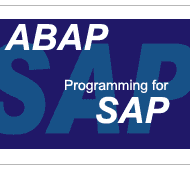Thursday, July 26, 2007
Topics going to cover in this blog
1. Development Servers.
2. Testing Servers.
3. Production Servers.
4. Implementation Servers.
5. Go live.
6. Support & Maintenance.
Development servers may be N number of servers but Testing and Production servers is only one.Go live involves brief technical demonstration.
The following topics are to be covered in this blog:
1. Data types.
2. Field symbols.
3. Control statements.
4. Structures.
5. Internal tables.
6. ABAP dictionary.
7. Module Programming or Modularization Techniques.
Types of Sub-routines :
7.1 Macro
7.2 Form
7.3 Function
8. Dialog Programming. - Used to design screen.
8.1 Selection Screen
8.2 Screen Painter
8.3 Menu Painter
8.4 Messages
8.5 Transaction Code
9. Report Creation or List Processing. - Used to create reports.
Types of Reports:
9.1 Standard
9.2 Classical
9.3 Interactive
10. Logical database.
11. File handling.
12. SAP script or Form painter. - Used to create printable reports with logos, pictures, etc.,
13. Smart Forms.
14. BDC(Batch Data Communication)
15. LSMW(Legacy System Migration Workbench)
16. RFC(Remote Function Call)
17. ALE(Application Link Enabling)
18. IDOC(Intermediate Document)
BDC and LSMW are used to migrate and uploading data from NON-SAP system to SAP.
RFC, ALE and IDOC are cross application techniques and used to establish connection between different servers.
IDOC is like a container to carry data between different servers.
Role of ABAP in SAP
The ABAP programming language was originally used by SAP developers to develop the SAP R/3 platform. It was also intended to be used by SAP customers to enhance SAP applications – customers can develop custom reports and interfaces with ABAP programming. The language is fairly easy to learn for programmers but it is not a tool for direct use by non-programmers. Good programming skills, including knowledge of relational database design and preferably also of object-oriented concepts, are required to create ABAP programs.
ABAP remains the language for creating programs for the client-server R/3 system, which SAP first released in 1992. As computer hardware evolved through the 1990s, more and more of SAP's applications and systems were written in ABAP. By 2001, all but the most basic functions were written in ABAP. In 1999, SAP released an object-oriented extension to ABAP called ABAP Objects, along with R/3 release 4.6.
SAP's most recent development platform, NetWeaver, supports both ABAP and Java.

As mentioned in the above figure no one can access the SAP database directly.If anyone needs any data from the database then they need to contact the ABAP-ers for generating those reports.So ABAP language is mainly used for generating reports.
BASIS is like an operating system for R/3. It sits between the ABAP code and the computer's operating system. SAP likes to call it middleware because it sits in the middle, between ABAP and the operating system. BASIS sits between ABAP and the operating system. ABAP cannot run directly on an operating system. It requires a set of programs (collectively called Basis) to load, interpret, and buffer its input and output. Basis, in some respects, is like the Windows environment. Windows starts up, and while running it provides an environment in which Windows programs can run. Without Windows, programs written for the Windows environment cannot run. Basis is to ABAP programs as Windows is to Windows programs.BASIS provides the runtime environment for ABAP programs. Without Basis, ABAP programs cannot run. When the operator starts up R/3, you can think of him as starting up Basis. Basis is a collection of R/3 system programs that present you with an interface. Using this interface the user can start ABAP programs.
 Thus BASIS people work involves providing various access privileges to different department people.And the ABAP people work creating programs in ABAP language for creating reports depending on the requirements from different departments people in the company.
Thus BASIS people work involves providing various access privileges to different department people.And the ABAP people work creating programs in ABAP language for creating reports depending on the requirements from different departments people in the company.
What is ABAP?
ABAP is one of many application-specific fourth-generation languages (4GLs) first developed in the 1980s. It was originally the report language for SAP R/2, a platform that enabled large corporations to build mainframe business applications for materials management and financial and management accounting. ABAP used to be an abbreviation of Allgemeiner Berichtsaufbereitungsprozessor, the German meaning of "generic report preparation processor", but was later renamed to Advanced Business Application Programming. ABAP was one of the first languages to include the concept of Logical Databases (LDBs), which provides a high level of abstraction from the basic database level.
The ABAP programming language was originally used by SAP developers to develop the SAP R/3 platform. It was also intended to be used by SAP customers to enhance SAP applications – customers can develop custom reports and interfaces with ABAP programming. The language is fairly easy to learn for programmers but it is not a tool for direct use by non-programmers. Good programming skills, including knowledge of relational database design and preferably also of object-oriented concepts, are required to create ABAP programs.
ABAP remains the language for creating programs for the client-server R/3 system, which SAP first released in 1992. As computer hardware evolved through the 1990s, more and more of SAP's applications and systems were written in ABAP. By 2001, all but the most basic functions were written in ABAP. In 1999, SAP released an object-oriented extension to ABAP called ABAP Objects, along with R/3 release 4.6.
SAP's most recent development platform, NetWeaver supports both ABAP and Java.
What is SAP?
SAP is the third largest software company in the world.
SAP is the largest business application and Enterprise Resource Planning (ERP) solution software provider in terms of revenue.
SAP's products focus on ERP, which it helped to pioneer. The company's main product is MySAP ERP. The name of its predecessor, SAP R/3 give a clue to its functionality: the "R" stands for realtime data processing and the number 3 relates to a 3-tier architecture: database, application server and client (SAPgui). R/2, which ran on a Mainframe architecture, was the first SAP version.
Other major product offerings include
Advanced Planner and Optimizer (APO),
Business Information Warehouse (BW),
Customer Relationship Management (CRM),
Supply Chain Management (SCM),
Supplier Relationship Management (SRM),
Human Resource Management Systems (HRMS),
Product Lifecycle Management (PLM),
Exchange Infrastructure (XI),
Enterprise Portal (EP) and
Knowledge Warehouse (KW).
The APO name has been retired and rolled into SCM. The BW name (Business Warehouse) has now been rolled into the SAP NetWeaver BI (Business Intelligence) suite and functions as the reporting module.
SAP applications, built around their latest R/3 system, provide the capability to manage financial, asset, and cost accounting, production operations and materials, personnel, plants, and archived documents. The R/3 system runs on a number of platforms including Windows 2000 and uses the clientt/server model. The latest version of R/3 includes a comprehensive Internet-enabled package.
SAP has recently recast its product offerings under a comprehensive Web interface, called mySAP.com, and added new e-business applications, including customer relationship management (CRM) and supply chain management (SCM).
SAP Overview
What is ERP?
ERP stands for Enterprise Resource Planning. ERP is a way to integrate the data and processes of an organization into one single system.
Integration is an extremely important part to ERP's.In order to achieve integration, most ERP systems use a unified database to store data for various functions found throughout the organization.
The Ideal ERP System :
An ideal ERP system is when a single database is utilized and contains all data for various software modules. These software modules can include:
Manufacturing: Some of the functions include; engineering, capacity, workflow management, quality control, bills of material, manufacturing process, etc.
Financials: Accounts payable, accounts receivable, fixed assets, general ledger and cash management, etc.
Human Resources: Benefits, training, payroll etc
Supply Chain Management: Inventory, supply chain planning, supplier scheduling, claim processing, order entry, purchasing, etc.
Projects: Costing, billing, activity management, time and expense, etc.
Customer Relationship Management: Sales and marketing, service, commissions, customer contact, calls center support, etc.
Data Warehouse: Usually this is a module that can be accessed by an organizations customers, suppliers and employees.
There are many advantages of implementing an EPR system; here are a few of them:
- A totally integrated system.
- The ability to streamline different processes and workflows.
- The ability to easily share data across various departments in an organization.
- Improved efficiency and productivity levels.
- Better tracking and forecasting.
- Lower costs.
- Improved customer service.
Disadvantages of ERP Systems :
While advantages usually outweigh disadvantages for most organizations implementing an ERP system, here are some of the most common obstacles experienced:
Usually many obstacles can be prevented if adequate investment is made and adequate training is involved, however, success does depend on skills and the experience of the workforce to quickly adapt to the new system.
- Customization in many situations is limited
- The need to reengineer business processes
- ERP systems can be cost prohibitive to install and run
- Technical support can be shoddy
- ERP's may be too rigid for specific organizations that are either new or want to move in a new direction in the near future.


